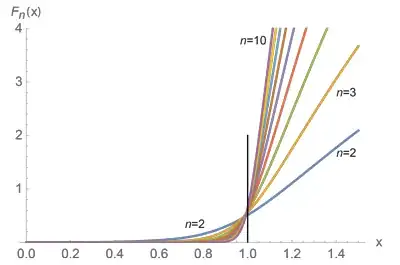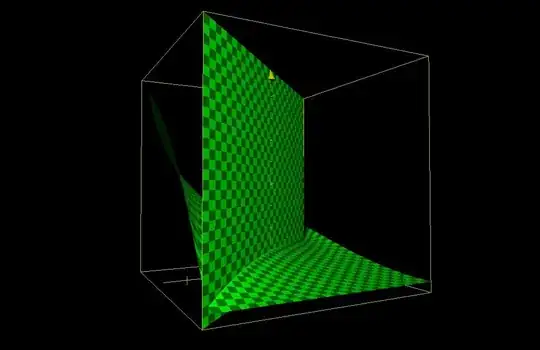This proof is mainly based on some of the suggestions in the early version of this answer. Also, we are building here on the comment by Peter Mueller concerning the polynomial $a$ defined below. It turns out that similar techniques can be used for all other nontrivial polynomials arising in the proof, which allowed us to replace multiple uses of Mathematica command Reduce[] in the last version of this answer by showing that the coefficients of the mentioned relevant polynomials are all nonnegative. I have still retained some use of Reduce[] -- but only to quickly make the routine check for $n\le11$.
Note that
\begin{equation}
G:=
F_n''(x) x^{2-2 n} \left(x^{2 n}+1\right)^2 \left(x^{4 n}+x\right)^2 \left(x^{2 n+1}-1\right)^2
\left(x^{2 n+1}+1\right)^2 \left(x^{2 n+2}-1\right)^2
\end{equation}
is a polynomial in $n$, $x$, and $y:=x^{2n}$, of degree $2$ in $n$:
\begin{equation}
G=a+bn+cn^2,
\end{equation}
where $a,b,c$ are certain polynomials in $x,y$.
The check of $G\ge0$ for $n=2,\dots,11$ is straightforward. So, assume $n\ge12$, whence $0<y<x^{24}<x^{12}$.
We also always assume that $0<x<1$, $0<y<x^{24}$ ,
\begin{equation}
n=\frac{\ln y}{2\ln x}; \tag{1}
\end{equation}
the latter relation is of course just another form of the equality $y=x^{2n}$.
Note that
$0<y<1\ \&\ 0<x<1$ implies $x=1/(1+u)\ \&\ y=1/(1+v)$ for some $u,v\ge0$.
As suggested by Peter Mueller, it turns out that
\begin{equation}
a\; (1 + u)^{10} (1 + v)^{11}|_{x=1/(1 + u), y=1/(1 + v)}
\end{equation}
is a polynomial in $u,v$ with all coefficients nonnegative.
Details of all calculations can be seen in the Mathematica notebook
and its pdf image
So,
\begin{equation}
a\ge0
\end{equation}
for all $x,y$ in $(0,1)$.
Next, introduce
\begin{equation}
x_* := \frac{869}{1000},\quad
x_0:=\frac{7655}{10000},\quad y_0:= x_0^{24}\approx0.00164,\quad
x_1 := \frac{985}{1000},\quad y_1:= x_1^{24}\approx0.696.
\end{equation}
The following cases/subcases/subsubcases are exhaustive:
Case 1: $y\le y_1$. Then the condition $0<y\le y_1\ \&\ 0<x<1\ \&\ 0<y<x^{24}$ implies $x=x_1/(1+u)\ \&\ y=x^{24}/(1+v)$ or $x=x_1+(1-x_1)/(1+u)\ \&\ y=y_1/(1+v)$ for some $u\ge0$ and $v\ge0$, depending on whether $x<x_1$ or $x\ge x_1$.
It turns out that
\begin{equation}
c\; (1 + u)^{248} (1 + v)^{10}|_{x=x_1/(1+u)\ \&\ y=x^{24}/(1+v)}
\end{equation}
and
\begin{equation}
c\; (1 + u)^{10} (1 + v)^{10}|_{x=x_1+(1-x_1)/(1+u)\ \&\ y=y_1/(1+v)}
\end{equation}
are each a polynomial in $u,v$ with all coefficients nonnegative.
So,
\begin{equation}
c\ge0 \quad\text{in Case 1}.
\end{equation}
So, for the derivative $G'_n$ of $G$ in $n$, we have
\begin{equation}\tag{2}
G'_n=b+2cn\ge b+24c=(G'_n)|_{n=12}.
\end{equation}
Now we have to distinguish two subcases of Case 1, with further subsubcases of Subcase 1.1:
Subcase 1.1: $y\le y_1$ and ($y\ge y_0$ or $x\le x_*$).
Subsubcase 1.1.1: $y\le y_1$ and $y\ge y_0$ and $x\ge x_1$. Then $y\le y_1\ \&\ y\ge y_0\ \&\ x\ge x_1 \ \&\ 0<x<1\ \&\ 0<y<x^{24}$ implies
$$x=x_{111}:=x_1+(1-x_1)/(1+u)\ \&\ y=y_{111}:=y_0+(y_1-y_0)/(1+v)$$
for some $u\ge0$ and $v\ge0$.
It turns out that
\begin{equation}
(G'_n)|_{n=12}\; (1 + u)^{10} (1 + v)^{11}|_{x=x_{111}, y=y_{111}}
\end{equation}
and
\begin{equation}
G|_{n=12}\; (1 + u)^{10} (1 + v)^{11}|_{x=x_{111}, y=y_{111}}
\end{equation}
are each, again, a polynomial in $u,v$ with all coefficients nonnegative.
Subsubcase 1.1.2: $y\le y_1$ and $y\ge y_0$ and $x<x_1$. Then $x=x_{112}:=x_0+(x_1-x_0)/(1+u)\ \&\ y=y_{112}:=y_0+(x^{24}-y_0)/(1+v)$ for some $u\ge0$ and $v\ge0$.
It turns out that
\begin{equation}
(G'_n)|_{n=12}\; (1 + u)^{272} (1 + v)^{11}|_{x=x_{112}, y=y_{112}}
\end{equation}
and
\begin{equation}
G|_{n=12}\; (1 + u)^{272} (1 + v)^{11}|_{x=x_{112},y=y_{112}}
\end{equation}
are each, again, a polynomial in $u,v$ with all coefficients nonnegative.
Subsubcase 1.1.3: $y\le y_1$ and $x\le x_*$. Then $x=x_{113}:=x_*/(1+u)\ \&\ y=y_{113}:=x^{24}/(1+v)$ for some $u\ge0$ and $v\ge0$.
It turns out that
\begin{equation}
(G'_n)|_{n=12}\; (1 + u)^{272} (1 + v)^{11}|_{x=x_{113},y=y_{113}}
\end{equation}
and
\begin{equation}
G|_{n=12}\; (1 + u)^{272} (1 + v)^{11}|_{x=x_{113},y=y_{113}}
\end{equation}
are each, again, a polynomial in $u,v$ with all coefficients nonnegative.
So, $G|_{n=12}\ge0$ and $(G'_n)|_{n=12}\ge0$ in all the three subsubcases of Subcase 1.1. In view of $(2)$, we have
$G\ge0$ in Subcase 1.1.
Subcase 1.2: $y\le y_1$ and $y<y_0$ and $x>x_*$. Then, of course, the condition $y\le y_1$ is redundant. Let here
\begin{equation}
\rho(x):=\frac7{2(1-x)}.
\end{equation}
The condition
$x_*<x<1\ \&\ 0<y<y_0$ implies $x=x_{12}:=x_*+(1-x_*)/(1+u)$ and $y=y_{12}:=y_0/(1+v)$ for some $u\ge0$ and $v\ge0$.
It turns out that
\begin{equation}
(G'_n)|_{n=\rho(x)/2}\; u\,(1 + u)^{10} (1 + v)^{11}|_{x=x_{12},y=y_{12}}
\end{equation}
and
\begin{equation}
G|_{n=\rho(x)/2}\; u^2\,(1 + u)^{10} (1 + v)^{11}|_{x=x_{12},y=y_{12}}
\end{equation}
are each, again, a polynomial in $u,v$ with all coefficients nonnegative.
So, similarly to Subcase 1.1, for all $n\ge\rho(x)/2$ we get $G\ge G|_{n=\rho(x)/2}\ge0$.
In Subcase 1.2, it remains to note that for our particular $n$, as in $(1)$, we indeed have $n\ge\rho(x)/2$. This follows because for $y<y_0$ and $x>x_*$
\begin{equation}
\ln\frac1y>\ln\frac1{y_0}>1.08\frac7{2(1-x_*)}\,\ln\frac1{x_*}
>\frac7{2(1-x)}\,\ln\frac1{x}=\rho(x)\ln\frac1{x}.
\end{equation}
So, $G\ge0$ in Subcase 1.2 as well.
It remains to consider
Case 2: $y>y_1$. Then condition $y>y_1\ \&\ 0<x<1\ \&\ 0<y<x^{24}[<x^{12}]$ implies $x=x_2:=x_1+(1-x_1)/(1+u),y=y_2:=y_1+(x^{12}-y_1)/(1+v)$ for some $u\ge0$ and $v\ge0$.
It turns out that
\begin{equation}
b\;(1 + u)^{140} (1 + v)^{11}|_{x=x_{2},y=y_{2}}
\end{equation}
is also a polynomial in $u,v$ with all coefficients nonnegative.
Hence, $b\ge0$ in Case 2.
So, if $c\ge0$, then trivially $G\ge0$ (since $a\ge0$ always). So, without loss of generality, $c<0$ and hence $G$ is concave in $n$. So, it is enough to bracket the $n$ as in $(1)$ between some simple rational expressions $n_1$ and $n_2$ such that $G|_{n=n_1}\ge0$ and $G|_{n=n_2}\ge0$.
In Case 2, $y$ is "close" to $1$ and hence, in view of inequality $y<x^{24}$, so is $x$: $x>y_1^{1/12}=x_1=0.985$. So, it is a bit more convenient here to change variables $x, y$ to "small variables" $u:=1-x$ and $v:=1-y$.
Then $0<v<1-y_1\approx0.304$ and $1-u=x>y^{1/24}=(1-v)^{1/24}>1-v/3$, whence $u<v/3$. Let now $t:=u/v$, so that $0<t<1/3$.
It follows, in Case 2, that $t=(1/3)/(1+r)$ and $v=(1-y_1)/(1+s)$ for some $r\ge0$ and $s\ge0$.
The mentioned brackets $n_1$ and $n_2$ are respectively $\ell_1/2$ and $\ell_2/2$, where
\begin{equation}
\ell_1:=\frac1t,\quad\ell_2:=\frac{(2 - v) (1 - t v)}{t (1 - v) (2 - t v)}.
\end{equation}
It is not hard to see (details on this are in the same Mathematica notebook) that then indeed $n_1 < n < n_2$.
It remains to show that $G|_{n=n_1}\ge0$ and $G|_{n=n_2}\ge0$.
It turns out that
\begin{equation}
(G'_n)|_{n=\ell_1/2;\,x=1-tv,\,y=1-v;\,t=(1/3)/(1+r),\,v=(1-y_1)/(1+s)}\; (1 + r)^{10} (1 + s)^{19}
\end{equation}
and
\begin{equation}
(G'_n)|_{n=\ell_2/2;\,x=1-tv,\,y=1-v;\,t=(1/3)/(1+r),\,v=(1-y_1)/(1+s)}\; (1 + r)^{10} (1 + s)^{19}\; q
\end{equation}
are each a polynomial in $r,s$ with all coefficients nonnegative,
where
\begin{multline*}
q:=
(1 + r)^{10} (1 + s)^{19} \\
\times(11673186598630578538556565100133681446610566511878526881 \\
+
16777216000000000000000000000000000000000000000000000000 s)^2 \\
\times\big(31853088866210192846185521700044560482203522170626175627 \\
+
33554432000000000000000000000000000000000000000000000000 (r + s +
r s)\big)^2.
\end{multline*}
The proof is complete.



![plot on [0,1]x[0,1]](../../images/f5cac66b77b7b006c7c1d8f202aeeb6d.webp)